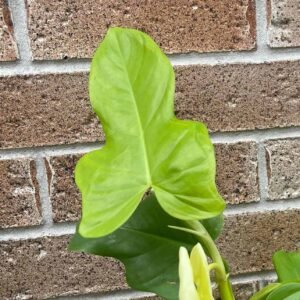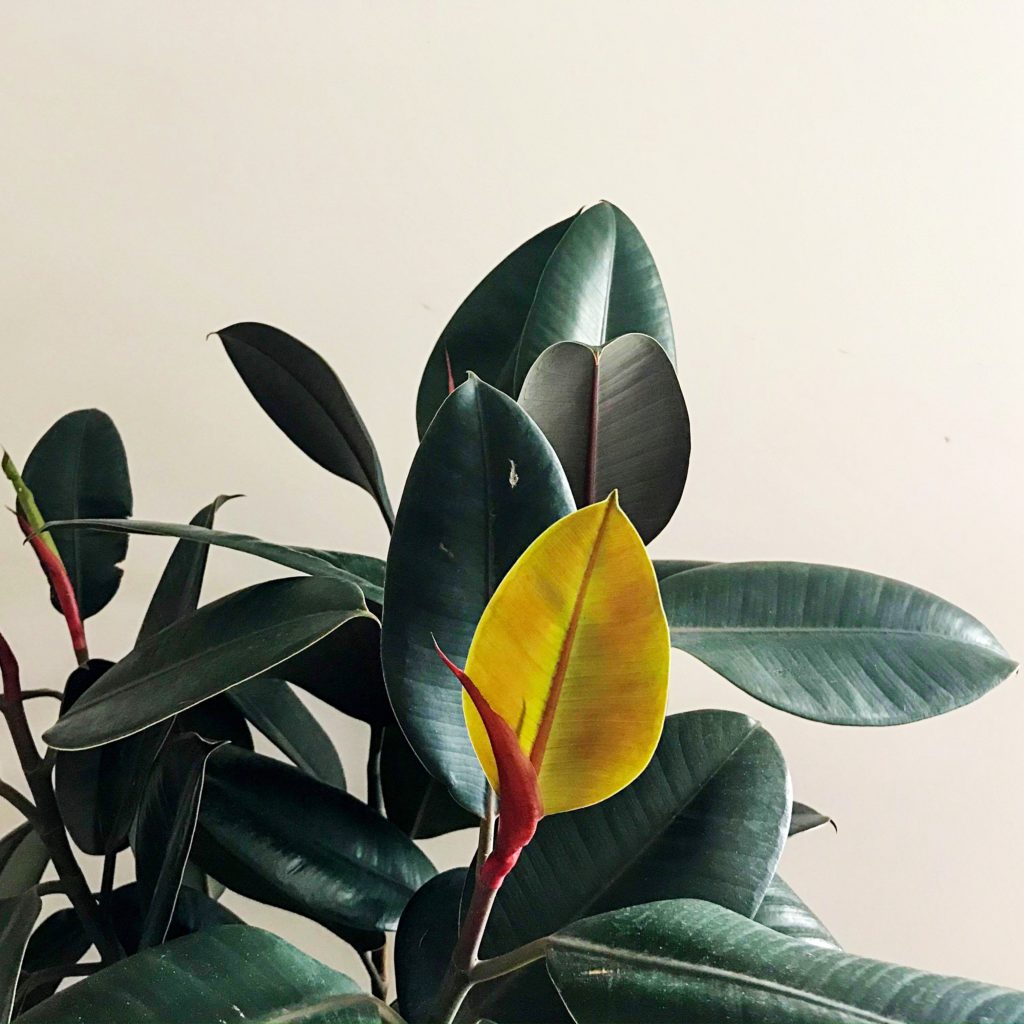Philodendron Bipennifolium Aurea a.k.a Philodendron Golden Violin, Horsehead Philodendron, Fiddleleaf Philodendron is a great addition to any indoor plant collection. Easy enough for both beginners to the hobby and veterans the vibrant, unique shaped leaves make a big statement. In this guide we will cover all of the basics for Philodendron Golden Violin Care.

Philodendron Golden Violin Quick Overview
| Full Size | 3-7 feet |
| Light | Moderate indirect light |
| Temperature | 75ºF-85ºF (24ºC-29ºC) |
| Humidity | Above 50% |
| Cost | $ |
| Care Level | Easy care |
| Toxicity | Toxic |
Size
The mature size of Philodendron Golden Violin can be upwards of 10 feet in height. The leaves can grow between 10-18 inches in length. The full size of a Philodendron Golden Violin when kept indoors can be between 3 to 7 feet in height.
This plant will grow best when grown up a trellis/pole. Providing your plant with a trellis or pole to climb up will encourage larger foliage. When in the correct living conditions, the Philodendron Golden Violin can be quite fast growing.
Light Requirements
Philodendron Golden Violin will grow best when in medium to bright indirect light. Any direct sunlight should be avoided as this can cause the foliage to burn. A sign that your Philodendron Golden Violin isn’t receiving enough light is the plant becoming leggy. This can be resolved by moving your plant to a position where it will receive brighter lighting. A sign that your plant is receiving too much direct light is the leaves turning yellow.
If your plant is housed in a spot that receives direct sunlight, adding a blind or curtain to your window will help to defuse the harsh sunlight to avoid burning the plants foliage. Alternatively, if you can’t seem to find that perfect spot in your home, you can always use grow lights. Just like direct sunlight, if your plant is sitting too close to the grow lights, they will burn the foliage. Keeping a safe distance of at least 60cm between your plant and the light will avoid any trouble.
Temperature
The ideal temperature for growing Philodendron Golden Violin is between 75ºF-85ºF (24ºC-29ºC). Since this plant is from tropical rainforests, it loves warmer temperatures and is quite sensitive to cooler temperatures. The ideal nighttime temperature is between 65ºF-70ºF (18ºC-21ºC). If kept in a spot outside of this temperature range for prolonged periods of time, you can expect it to develop health issues, seize growing and in severe cases, plant death.
Humidity
Philodendron Golden Violin will thrive when kept in a humidity environment that is kept above 50%. As this plant is originally from tropical rainforests, it loves warmer temperatures and humidity. Keeping plants in a spot where there isn’t adequate humidity levels can make them more vulnerable to pests and diseases.
Providing a high humidity for your plants will encourage bigger and healthier growth. There are a few thing you can do that can help bump up the humidity in your home. The things you can try are:
- Misting your plants
- Pebble trays
- Grouping plants together
- Humidifier
- Greenhouse
Watering Requirements
You can expect your Philodendron Golden Violin to require moderate watering (at lease once a week depending on your environment). Throughout the cooler months this will change because the temperature and amount of sunlight is changing.
Before you water your plant, you should check to top 1-2 inches of soil to feel if it’s dry. If the soil feels dry, you should give your plant a drink. Drooping/wilting leaves can be a sign that your Philodendron Golden Violin is thirsty.
When it comes to watering your indoor plants, you need to be cautious of over-watering. Excess water to the soil can cause it to become waterlogged and the roots will begin to rot. When the roots have rotted, they no longer take up any water or nutrients for the plant. This can cause fungus issues, pest problems and root-rot.
Ensuring your plants are potted in pots with adequate drainage and well draining soil can assist in avoiding these common mistakes. A sign that your Philodendron Golden Violin may have been over-watered is leaves becoming discolored and stunted/slow growth.
Fertilizing Requirements
Your Philodendron Golden Violin should be fertilised approximately every 3 months with a slow release fertiliser. Fertilising your houseplants will give them the essential nutrients they need for promoting and maintaining new and healthy growth.
Slow release fertilisers don’t need to be used as often as a liquid fertiliser and the plant will take the nutrients as it needs them. You should apply the slow release fertiliser to moist soil and as per packet instructions. For more information on the different types of fertiliser for indoor plants click here.
When it comes to fertilising your indoor plants, you need to be cautious of over-fertilising. Over-fertilising your Philodendron Golden Violin can burn and damage the roots and foliage. If you think you may have over-fertilised your plant, you can change the soil or rinse the fertiliser out of the soil with water. You will notice a change in the water colour once the fertiliser has been rinsed out.
Soil Requirements
Philodendron Golden Violin will grow best planted in a well draining soil. To create a well draining soil mix, use a mixture of premium potting mix, orchid bark, perlite, peat moss and charcoal. These ingredients used together help to create better drainage and aeration. Adding perlite to any general all purpose potting mix can also be used as a simpler and easier mix.
Airflow is important in potting soil as it allows the plants roots to breath. Not having enough oxygen to the plants roots can eventually cause them to start rotting. Combining a well draining soil and pots with drainage will assist in avoiding over-watering your plants. For more information on the best potting soil to use for indoor plants see our guide to indoor plant soil.
You can also add organic materials like coco coir, mulch chunks or coconut husk to the soil to help restrain moisture. When it comes to potting soil for your indoor plants, you want to use a mix that will hold onto moisture without causing the soil to become soggy. Adding garden compost or worm castings to the soil will add more richness which plants love.
Diseases & Pests
The most common pests that you may encounter on your Philodendron Golden Violin are mealybugs, scale, spider mites, thrips and aphids. For more information on identifying and treating common houseplant pests click here. The most common diseases you may encounter are root-rot and Erwinia blight.
The best thing you can do when it comes to pests on houseplants is to try and avoid any pest infestations from starting. There are a few things you can do that will assist in preventing any pest infestations and these things are:
- Checking new plants for pests or isolating new plants for up to a week.
- Check your plants every few days for pests.
- Trim off any dead or dying leaves.
- Wipe down leaves if you notice them getting dusty.
- Keeping your plants healthy. A healthy plant will be able to handle an infestation better than those that aren’t as happy.
- Isolate any plants that have pests.
Following this will assist in keeping pests away as well as catch them early on before any severe infestations are able to start. Keeping plants healthy and in the correct living environments can help to deter any pests from invading your plants.
Toxicity
Philodendron Golden Violin is considered to be toxic to both pets and humans if ingested. This plant contains calcium oxalate crystals and if any part of the plant is ingested, symptoms may include swelling of the oesophagus, GI tract and mouth. If ingested by pets, the symptoms may include vomiting, lack of appetite, drooling and pawing at the mouth. Plant should be kept out of reach of small children and pets.



